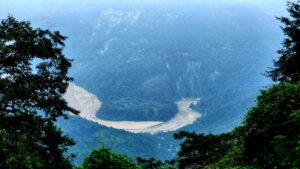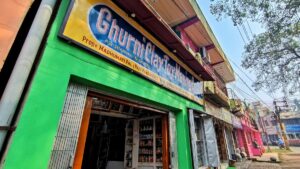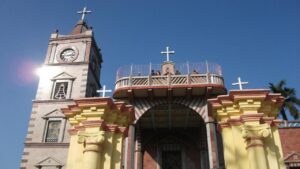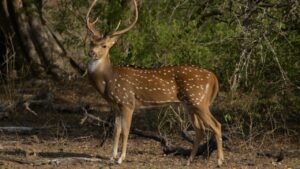Krishnanagar is a beautiful town with a religious ambiance and exciting historical tales.
Among many famous attractions in the area, Krishnanagar Rajbari is a pivotal historical heritage site that attracts thousands of visitors every year, especially during the auspicious festivals.
The walls of Krishnanagar Rajbari have seen various historical events over the years, filled with battles, Durga Puja, silver artifacts, and preserved galleries.
ADVERTISEMENT
The Rajbari’s entrance is particularly notable due to its vibrant colors and colonial appeal.
In this article, you will get to know the following points about Krishnanagar Rajbari,
- Timings
- Entry Fee
- How to reach
- History
- Architecture
- Best time to visit
- Trip during Durga Puja
- Jagadhatri Puja
- Nearby attractions
Let’s see each of these points in detail.
Timings of Krisnanagar Rajbari
Krisnanagar Rajbari ground is open throughout the day. There are no separate timings.
However, entry to the Rajbari Nat Mandir is only possible during Durga Puja, Jagadhatri Puja and Baro Dol.
Krisnanagar Rajbari Entry Fee
Krisnanagar Rajbari is free to enter.
How to reach the Krisnanagar Rajbari
By Train:
You can easily reach Krishnanagar Rajbari by taking the Krishnanagar City local train from the Sealdah junction. Then you can hire a rickshaw or a cab from the railway station to take you to this beautiful Rajbari.
A local train ticket from Sealdah to Krisnanagar costs around Rs. 25.
ADVERTISEMENT
By Bus:
There are many buses available from Esplanade as well. You can take any of the buses to reach Krishnanagar. From there, take an auto-rickshaw or Toto towards the Rajbari.
It would cost you around Rs. 500-700 (AC Buses).
By Car:
You can also reach Krishnanagar from Kolkata in private cars or cabs via NH16. The distance is about 110 km, which takes approximately 4 hours.
History of Krishnanagar Rajbari
The beautiful grand palace or Rajbari standing in the backdrop of the beautiful blue sky represents a glorious past of 200 years. It dates back to British rule in India.
The facade tells us about the battles fought here, the illustrious Durga Puja, the preserved galleries, and the silver artifacts are the epitome of aristocracy and sublime history.
The palace is said to have been named after Krishna Chandra Ray (1728–1782). Previously, the city was known as ‘Reui.’
This Rajbari, built here during the reign of Zamindar Krishna Chandra Roy, is a popular tourist destination. However, the remnants of its former glory have eroded, and only a dilapidated structure with carvings on its inner walls remains.
The architecture of Krishnanagar Rajbari
The structure of the opulent palace of Krishnanagar is similar to a Rajasthani ‘Kothi’ but is primarily wrapped in terracotta architecture. This was Maharaja Krishnachandra’s palace and is one of the most beautiful attractions in and around Krishnanagar.
The Krishnanagar Rajbari, though underrated as a weekend destination, still draws large crowds due to its massive Thakurdalan, ancient Goddess idol, and Persian Jhumar.
The entire Thakurdalan is covered in grand arches leading to the main temple of the goddess, the Rajbari rooms, the gallery where items are displayed, and the Shiv Temples. This location is also famous for picnics due to its well-kept lawns.
ADVERTISEMENT
The palace’s main attraction is the Durga temple.
The main shrine is said to be made of gold, and a grand festival is held in the Nat Mandir during Jagadhatri Puja. The interior of the nat mandir is beautiful to look at, especially the “Pankher Kaaj.”
Because the royal family was devotees of Lord Krishna, the entire arches and walls are adorned with beautiful carvings of the Lord and his lovers.
Just across the street, you can visit the museum and witness the plethora of historical artifacts on display, the most famous of which is the Chest of Raja Chandra, the 18th-century clay figures, swords, guns, clothes, and books.
Best time to visit Krishnanagar Rajbari
The best time to visit Krisnanagar Rajbari is in April when the Barodol Mela takes place on the Rajbari ground.
Another ideal time to visit this place is during the major festivities of Durga Puja and Jagaddhatri Puja. During this time, the palace looks glorious as the occasions take place.
Trip to Krishnanagar Rajbari during the Durga Puja
Visiting the Krishnanagar Rajbari during the Durga Puja was my long-time wish.
After a lot of planning and arrangements, I reached Krisnanagar on Mahalaya and stayed at a relative’s house. From there, I went to the Rajbari.
Ambiance
A different spiritual aura prevailed in the royal palace with the aroma of the Shiuli flowers and Dhuno. The entire Rajbari was beautifully decorated with flowers and light.
A fascinating thing I learned about this Rajbari is that Durga Puja getting celebrated here for the past 300 years.
ADVERTISEMENT
The energetic beauty infused in the idol of Raj Rajeshwari Durga in the form of a warrior and a lion resembling a horse is something I cannot explain in words.
The palace was crowded, as Mahalaya means several rituals, including Chokkhu Daan.
I was strolling along the palace and learned some important facts from a caretaker.
History
Durga Puja was started in the palace by Maharaja Rudra Roy, the great-grandfather of Krishna Chandra Roy. Devi Durga was worshiped to bring peace and prosperity to the people of Nadia.
The beautiful Durga Temple is built in the palace’s central courtyard.
The palace is surrounded by a ‘Dighi’ or water body. The reflection of the temple and its idol on this ‘Dighi’ is simply beautiful. I clicked a few photos of the Maa Durga Idol and the Dighi.
Sadhan Pal, who passed away in 1967, created the first idol, and its appearance has undergone minor changes since then. The two hands of Devi Maa in front are shorter than the eight hands behind. The Dashavatar, as well as the Dasamahavidya, are depicted on the Chal Chitra.
Rituals
After the Mahalaya, the Rani of the Rajbari begins the puja with a special Homagni or lighting of the fire. This ritual fire will continue to burn until Navami.
The ornamentation of the idol in the Raj Rajeshwari style differs from the traditional ‘Daker Saaj’ found in most Bonedi Barir Pujo in Kolkata. Rather this Saaj is known as the ‘Bedeni Dak.’
There was a time when the Sandhipujo (the puja between Ashtami and Navami) was celebrated with great fanfare by blowing the Rajbari’s cannons so the sound could be heard far and wide. The Cannons are no longer used in the Sandhipujo ritual, which is now performed with 108 lotus flowers and 108 lit lamps.
ADVERTISEMENT
Previously, goat sacrifice was performed in Durgapujo. Things have changed, and now only sugarcane and rice are sacrificed.
According to legend, the Raj Rajeswari look is an incarnation of Goddess Lakshmi, the goddess of wealth and happiness. The warrior goddess is thought to save the world and the people of Nadia by fighting against all evils, such as poverty, hunger, cruelty, corruption, persecution, illiteracy, suppression, immorality, gender inequality, sorrow, and pain.
After the idol is immersed, the family celebrates a ritual called ‘Shatru Badh’ as part of the four-day festival. According to legend, King Krishna Chandra (1710-1782) initiated this ritual by praying to Durga for power to eliminate people’s grievances and the evil force.
During Shatru Badh, a royal family member who represents the king takes up a bow and arrow and shoots at a clay model of the enemy.
The Sindur Khela is still a royal affair in which around 10,000 women participate. Another prominent ritual is Jatramangal, in which the king comes out to meet and interact with the people.
Prasad
On all four days of the puja, visitors are given prasad. The offerings are as magnificent as the puja itself.
The offerings begin with Mahalaya, and on Saptami, seven different types of fried items are given, while on Ashtami, eight different types of fried items are given, along with pulao and Chhanar Dalna, sweets, and kheer.
Prasad on Navami is Amish (non-vegetarian) and consists of nine fried items, three types of fish, rice, and sweets. Dashami is celebrated with a special Bhog of boiled rice, Singhi fish, fruits, curd, and Khoi.
ADVERTISEMENT
I enjoyed the puja in the Rajbari. The sound of dhak, Kanshor, and couch, the aroma of incense sticks and Dhuno, the Dhunuchi Nach, Jatramangal, and the Sindoor Khela gave me an unforgettable memory.
Before leaving for my home after spending a beautiful puja week, a relative whose house I was staying at told me to stay there until the renowned and more pronounced Jagadhhatri Puja. I was feeling so overwhelmed by the way they greeted me so warmly. But unfortunately, I could not stay back due to my work.
They told me a brief history of the Jagaddhatri Pujo in Krishnanagar Rajbari. I have penned down the history of the glorious Jagaddhatri puja below.
Jagaddhatri Pujo celebrations of Krishnanagar Rajbari
History of Krisnanagar Rajbari Jagaddhatri Pujo
According to legends, it is said that Maharaja Krishna Chandra was once imprisoned in Munger and thus could not attend the Durga Puja in 1762. He was heartbroken because he couldn’t offer Puspanjali to Maa Durga. It was Dasami at the time, and the puja had already concluded, with the idols immersed in the river.
He was making his way back by boat. When he realized Durga puja was over, the Maharaja burst into tears. When he dozed off, he had a dream. Teenaged Debi sitting on a lion resembling a white horse, telling him not to be disheartened and informing him that the goddess would return to him about a month later on the Sukla Nabami tithi in the Bengali month of Kartick (October-November).
So he instructed an artisan to build the idol of Devi Jagatdhatri. When it was carved, it looked similar to what he had seen in his dream.
ADVERTISEMENT
The appearance of the Devi
The goddess appeared to be a teenager, and the white lion in which she sat was facing the front.
The lion resembled the chessboard’s knight. Devi Jagaddhari had four hands and was armed with a conch (Sankha), a discus (Chakra), a bow, and an arrow.
The Maharaja would perform puja for Maa Jagaddhatri first and then enter the palace.
Rituals of Krisnanagar Rajbari Jagaddhatri Pujo
The family still follows an age-old tradition. On Nabami, all three pujas, Saptami, Ashtami, and Nabami, including Sandhi puja, are performed.
The puja begins in the morning with the offering of khichuri (a rice and pulse preparation) and nine different types of ‘Bhaja’ (fry). The bhog served here is not vegetarian and contains fish. Boli, or goat sacrifice, had ceased for ages. Instead, sugarcane, Chalkumra, and bananas are sacrificed. The Sandhi puja, which takes place after the Ashtami puja on the same day, is an iconic part of this festival.
Other attractions near Krisnanagar Rajbari
While in Krisnanagar, I decided to visit the nearby attractions, as I was eager to see how this beautiful city was all set for the grand festivity. The touch of Sarodiya Utsab was sprinkled all over the city.
Krishnanagar was very important to the Christian Missionaries. During the 1840s, the Protestant Church was built here, and I visited the church. I also went to the Roman Catholic Cathedral, built in 1898.
ADVERTISEMENT
I knew that Krishnanagar was famous for making clay models. I visited Ghurni to glimpse the artisans and the eye-catching clay idols.
Mayapur Dham is also a must-visit destination near Krisnanagar.
As a sweet-toothed, I did not skip the golden opportunity to taste the dishes like Sarbhaja, Krishnanagar Rajbari, Sarpuria, and of course, the mouth-watering sweets of Adar Chandra Das.
These are some of the facts and information about the Krisnanagar Rajbari that you should know about.
Time had just flown like a whoosh! I didn’t want to leave this palace. But with a heavy heart, I made my way back home. Next year, I will visit the Rajbari during the auspicious Boraodol Mela and Jagaddhatri Pujo.
Krishna Nagar is one of the prime centers in Nadia. It is also one of the religious places in West Bengal and a fulcrum of important literature and culture.
Other places to visit in West Bengal
- Ramdhura (Kalimpong) – 5 Points You Must Know About

- Daragaon, Burmaik (Kalimpong) – 5 Points You Must Know About

- Ghurni – Exploring Krishnanagar’s Hidden Gem And Its Clay Dolls

- Mim Tea Garden (Darjeeling) – 5 Points You Must Know About

- Bandel Church (Hooghly) | The Basilica of the Holy Rosary

- Bethuadahari Wildlife Sanctuary (West Bengal) – 5 Things To Know

Disclaimer: Some of the links provided in the article may contain affiliate links. This means when you book or buy something using these links, you help support the website at no extra cost.

